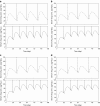Sustained-release delivery of octreotide from biodegradable polymeric microspheres
- PMID: 21948321
- PMCID: PMC3225556
- DOI: 10.1208/s12249-011-9693-z
Sustained-release delivery of octreotide from biodegradable polymeric microspheres
Abstract
The study reports on the drug release behavior of a potent synthetic somatostatin analogue, octreotide acetate, from biocompatible and biodegradable microspheres composed of poly-lactic-co-glycolic acid (PLGA) following a single intramuscular depot injection. The serum octreotide levels of three Oakwood Laboratories formulations and one Sandostatin LAR(®) formulation were compared. Three formulations of octreotide acetate-loaded PLGA microspheres were prepared by a solvent extraction and evaporation procedure using PLGA polymers with different molecular weights. The in vivo drug release study was conducted in male Sprague-Dawley rats. Blood samples were taken at predetermined time points for up to 70 days. Drug serum concentrations were quantified using a radioimmunoassay procedure consisting of radiolabeled octreotide. The three octreotide PLGA microsphere formulations and Sandostatin LAR(®) all showed a two-phase drug release profile (i.e., bimodal). The peak serum drug concentration of octreotide was reached in 30 min for all formulations followed by a decline after 6 h. Following this initial burst and decline, a second-release phase occurred after 3 days. This second-release phase exhibited sustained-release behavior, as the drug serum levels were discernible between days 7 and 42. Using pharmacokinetic computer simulations, it was estimated that the steady-state octreotide serum drug levels would be predicted to fall in the range of 40-130 pg/10 μL and 20-100 pg/10 μL following repeat dosing of the Oakwood formulations and Sandostatin LAR(®) every 28 days and every 42 days at a dose of 3 mg/rat, respectively.
Figures




Similar articles
-
Minimizing the initial burst of octreotide acetate from glucose star PLGA microspheres prepared by the solvent evaporation method.Int J Pharm. 2022 Aug 25;624:121842. doi: 10.1016/j.ijpharm.2022.121842. Epub 2022 May 21. Int J Pharm. 2022. PMID: 35609832
-
Controlled release of octreotide and assessment of peptide acylation from poly(D,L-lactide-co-hydroxymethyl glycolide) compared to PLGA microspheres.Pharm Res. 2012 Jan;29(1):110-20. doi: 10.1007/s11095-011-0517-3. Epub 2011 Jul 9. Pharm Res. 2012. PMID: 21744173 Free PMC article.
-
Modeling the kinetics of release of octreotide from long-acting formulations injected intramuscularly in rabbits.J Pharm Sci. 2000 Sep;89(9):1123-33. doi: 10.1002/1520-6017(200009)89:9<1123::aid-jps4>3.0.co;2-k. J Pharm Sci. 2000. PMID: 10944377
-
Fabrication and Use of Poly(d,l-lactide-co-glycolide)-Based Formulations Designed for Modified Release of 5-Fluorouracil.J Pharm Sci. 2018 Feb;107(2):513-528. doi: 10.1016/j.xphs.2017.10.012. Epub 2017 Oct 16. J Pharm Sci. 2018. PMID: 29045885 Free PMC article. Review.
-
Injectable controlled release depots for large molecules.J Control Release. 2014 Sep 28;190:240-53. doi: 10.1016/j.jconrel.2014.05.057. Epub 2014 Jun 12. J Control Release. 2014. PMID: 24929039 Free PMC article. Review.
Cited by
-
Injectable Sustained-Release Depots of PLGA Microspheres for Insoluble Drugs Prepared by hot-Melt Extrusion.Pharm Res. 2017 Oct;34(10):2211-2222. doi: 10.1007/s11095-017-2228-x. Epub 2017 Jul 24. Pharm Res. 2017. PMID: 28741064
-
The Advances in Phospholipids-Based Phase Separation Gels for the Sustained Release of Peptides, Proteins, and Chemotherapeutics.Pharmaceutics. 2024 Jun 29;16(7):875. doi: 10.3390/pharmaceutics16070875. Pharmaceutics. 2024. PMID: 39065572 Free PMC article. Review.
-
Population Pharmacokinetic Analysis of an Octreotide Depot (CAM2029) in the Treatment of Acromegaly.Clin Pharmacokinet. 2025 Jul;64(7):1079-1092. doi: 10.1007/s40262-025-01522-3. Epub 2025 May 26. Clin Pharmacokinet. 2025. PMID: 40418492 Free PMC article. Clinical Trial.
-
IVIVC of Octreotide in PLGA-Glucose Microsphere Formulation, Sandostatin® LAR.AAPS PharmSciTech. 2022 Sep 19;23(7):258. doi: 10.1208/s12249-022-02359-w. AAPS PharmSciTech. 2022. PMID: 36123513
-
Terpenes from Cannabis sativa induce antinociception in a mouse model of chronic neuropathic pain via activation of adenosine A 2A receptors.Pain. 2024 Nov 1;165(11):e145-e161. doi: 10.1097/j.pain.0000000000003265. Epub 2024 May 2. Pain. 2024. PMID: 38709489
References
Publication types
MeSH terms
Substances
LinkOut - more resources
Full Text Sources
Miscellaneous

